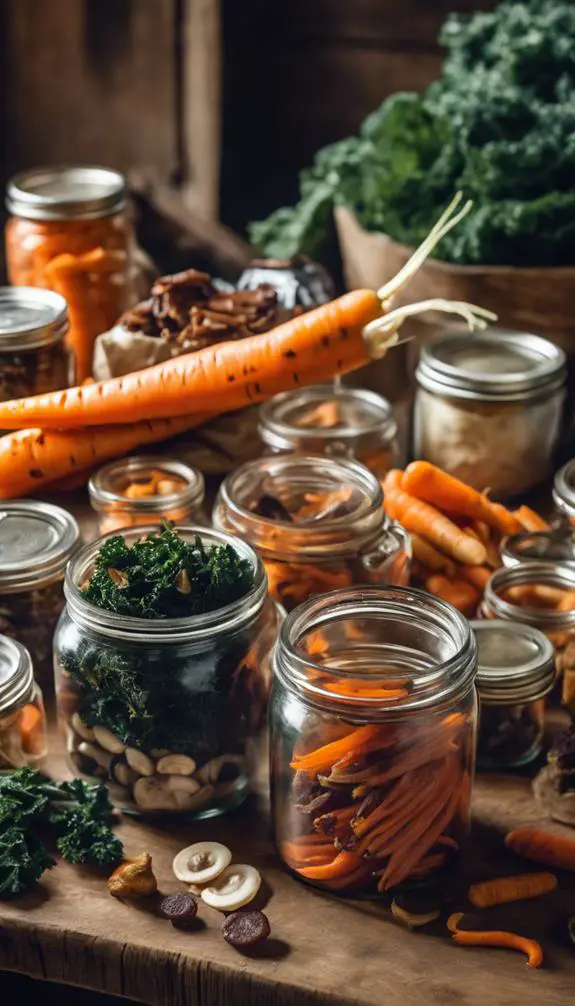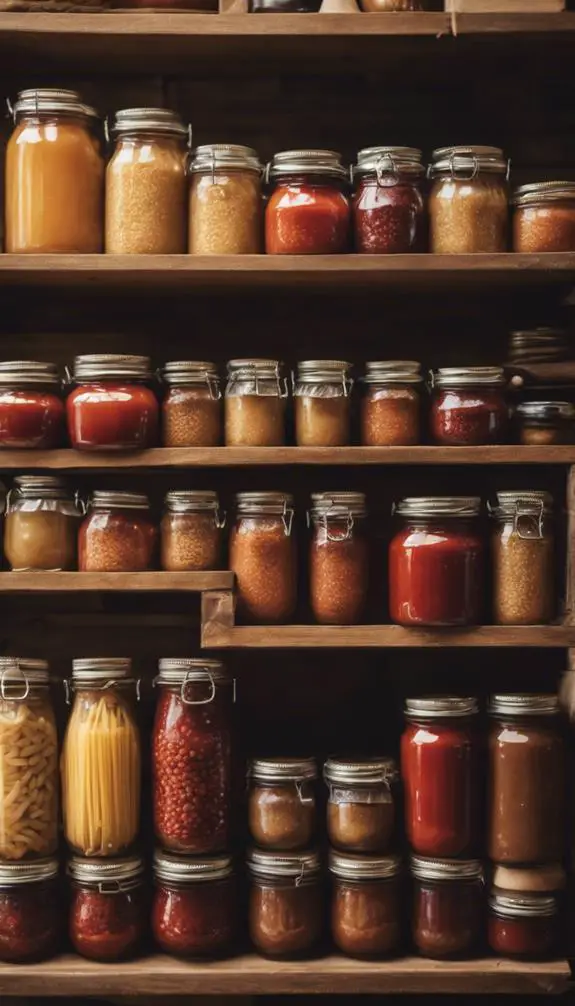When building your long-term survival storage, you'll want to focus on dehydrating foods that provide a balance of nutrients, energy, and satisfaction. You're likely thinking about the staples like fruits, veggies, and protein-rich meats, but what about the extras that'll make a real difference in a survival situation? You'll want to ponder dehydrating foods that can be easily reconstituted into whole meals, as well as healthy snack options that'll keep you and your loved ones going. But which specific foods will give you the best bang for your buck – and your survival?
Summary
- Dehydrated fruits and veggies provide essential nutrients, are lightweight, and have a long shelf life, making them ideal for long-term survival storage.
- Protein-rich foods like beef jerky, poultry, and dehydrated dairy alternatives are crucial for sustenance in emergency situations.
- Dehydrated snacks like kale chips, sweet potato fries, and apple chips offer a healthy and satisfying crunch for on-the-go energy boosts.
- Whole meals like chicken fajitas, beef stew, and vegetable soup can be dehydrated for convenient rehydration in emergency situations.
- Gluten-free dehydrated options like rice, corn, and quinoa are vital for those with gluten intolerance or sensitivity, providing healthy and sustainable storage solutions.
Dehydrated Fruits for Survival

When disaster strikes, having a stash of dehydrated fruits can be a lifesaver, providing essential nutrients and energy to keep you going.
You'll appreciate the lightweight, compact, and nutritious Dried Delicacies that can be easily stashed away in your survival kit. Fruit Leathers are another great option, offering a sweet and healthy snack that's perfect for on-the-go.
By dehydrating fruits, you'll preserve their natural goodness while eliminating the need for refrigeration. This means you can enjoy your favorite fruits year-round, even in the most challenging situations.
Dehydrated fruits are also rich in fiber, vitamins, and antioxidants, making them an excellent addition to your emergency food supply.
Veggie Delights for Long Term Storage
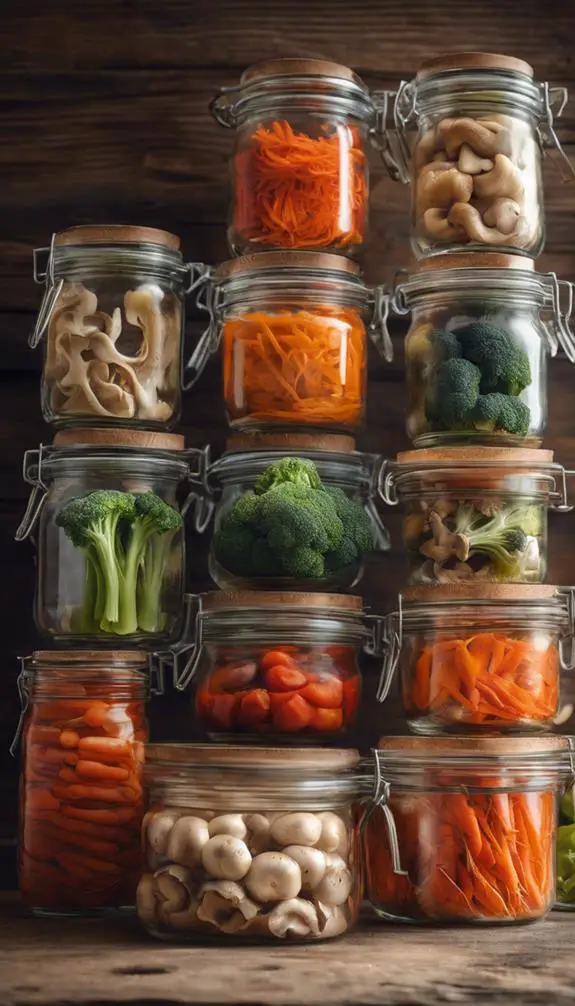
Stock up on dehydrated veggies and you'll be set for the long haul, enjoying a steady supply of nutritious and delicious additions to your meals.
You can create your own veggie blends using a mix of dehydrated carrots, broccoli, and peas, or opt for a pre-made blend.
When dehydrating your garden harvest, make sure to dry them to the ideal moisture level to preserve their flavor and nutrients.
Dehydrated veggies are perfect for adding crunch and flavor to soups, stews, and salads.
They're also a great way to sneak in some extra nutrients into your meals.
With dehydrated veggies, you'll have a steady supply of healthy additions to your meals, no matter the season.
Protein-Rich Meat Preservation
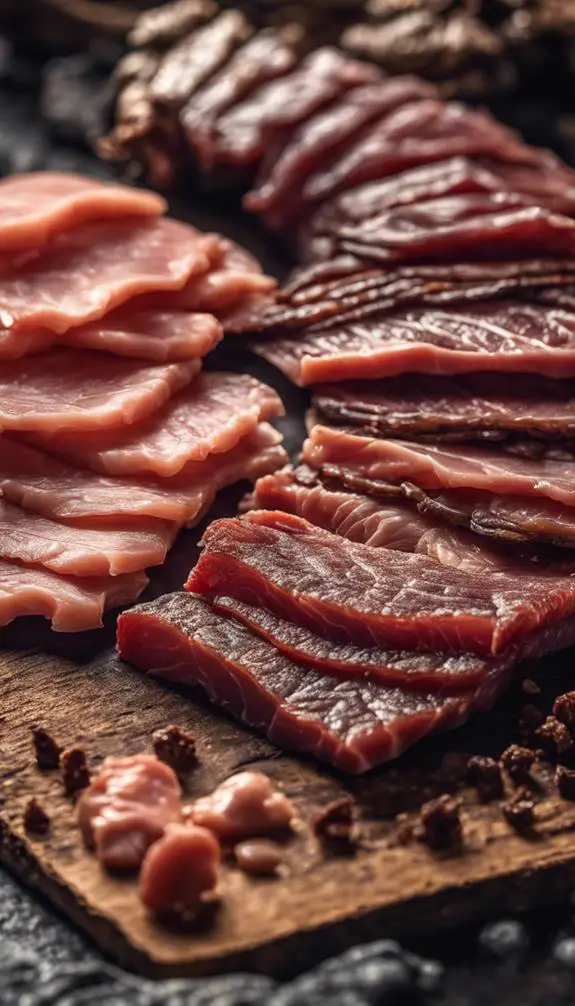
You're about to reveal the secrets of preserving protein-rich meats through dehydration.
First, you'll learn the beef jerky basics, from selecting the right cuts of meat to achieving that perfect chewy texture.
Then, you'll discover poultry preservation tips to guarantee your chicken, turkey, or duck jerky is safe to eat and packed with flavor.
Beef Jerky Basics
About 30 pounds of beef jerky are consumed every second in the United States alone, making it a staple in many outdoor enthusiasts' and health-conscious individuals' diets.
When preparing beef jerky for long-term survival storage, you'll want to focus on selecting the right cuts of meat. Opt for lean beef strips, such as top round or flank steak, as they'll yield a more tender and flavorful jerky.
Slice the meat to an ideal thickness of about 1/4 inch to guarantee even drying. Trim any excess fat to prevent spoilage and promote a longer shelf life.
Poultry Preservation Tips
Your poultry preservation journey begins with selecting the right cuts of meat, as not all bird parts are created equal when it comes to dehydrating.
Opt for boneless, skinless breast or tenderloins for the best results. When it comes to poultry safety, make sure to handle the meat safely by washing your hands thoroughly and preventing cross-contamination.
For Turkey techniques, try slicing the meat thinly to certify even drying.
You can also marinate the meat in your favorite seasonings before dehydrating to add flavor. Remember to set your dehydrator to 160°F to guarantee food safety.
Whole Meal Options for Emergencies

When preparing for emergencies, you'll want whole meal options that are easy to store and consume.
You'll benefit from creating emergency meal packs that include dehydrated ingredients, as well as ready-to-eat options like freeze-dried meals.
Emergency Meal Packs
Emergency situations can strike at any moment, leaving you without access to basic necessities, including food.
That's why it's vital to have a well-stocked emergency meal pack. When creating your pack, focus on meal planning to guarantee you're covering all your nutritional bases.
Aim for a minimum of three meals per day, with a balance of protein, complex carbs, and healthy fats. Consider pack configuration to maximize storage space and minimize weight.
Organize your meals into individual portions, and include a water purification method or sufficient water storage.
With a thoughtfully planned emergency meal pack, you'll be better equipped to handle unexpected crises and maintain your independence.
Ready-to-Eat Options
In lieu of cooking from scratch, ready-to-eat options provide a convenient and timely solution for emergency situations.
You can dehydrate whole meals like chicken fajitas, beef stew, or vegetable soup, which can be easily rehydrated when needed.
When using dehydration methods, it's vital to follow proper food safety guidelines to prevent spoilage and contamination.
Dehydrate ingredients to a moisture level of 10% or lower to guarantee food safety.
Store dehydrated meals in airtight containers to maintain freshness and shelf life.
With ready-to-eat options, you'll have peace of mind knowing you have a reliable food supply in emergency situations.
Shelf-Stable Meals
You can create shelf-stable meals by dehydrating whole meal options that cater to your specific dietary needs and preferences.
This approach guarantees food security and allows you to have control over the ingredients used. By dehydrating entire meals, you can enjoy convenience and flexibility during emergencies.
Meal planning becomes easier as you can simply rehydrate your meals when needed. Consider dehydrating soups, stews, casseroles, and other one-pot meals that can be easily reconstituted with hot water.
This way, you'll have a stockpile of healthy, ready-to-eat meals that can be stored for long periods, providing you with peace of mind and a sense of freedom.
Healthy Snack Alternatives
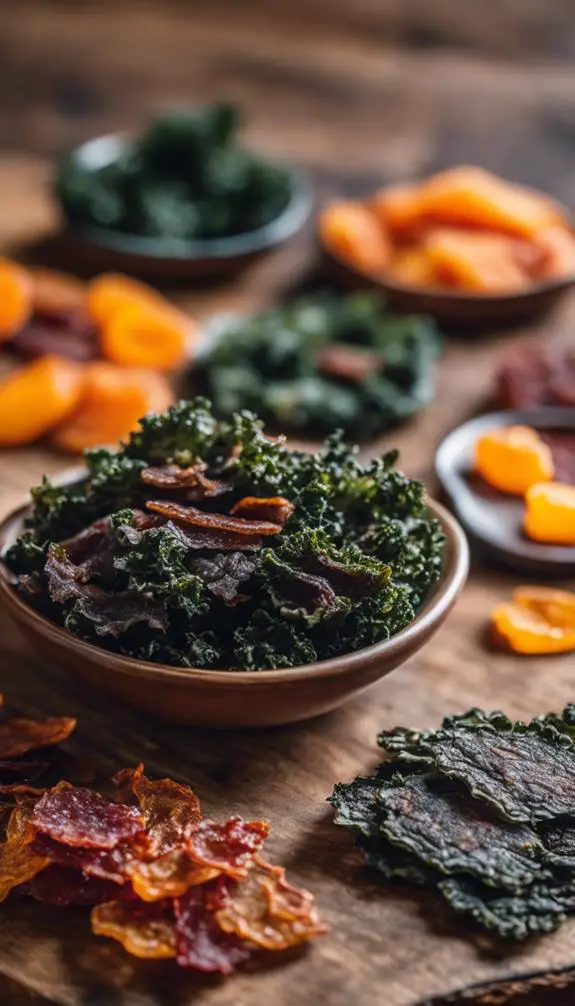
Snack time often finds you reaching for convenient, yet unhealthy options.
But, you know that's not doing your body any favors. Dehydrating healthy alternatives is a great way to curb those cravings without compromising your values.
Crunchy treats like kale chips, sweet potato fries, and apple chips are all easy to make and offer a satisfying crunch without the guilt.
You can also try dehydrating trail mix with nuts, seeds, and dried fruits for a healthy pick-me-up.
These snacks are perfect for on-the-go or as a quick energy boost.
Long-Shelf Life Granola Recipes

You're about to create a long-shelf life granola recipe that's tailored to your taste preferences.
To get started, you'll need to master the essentials of a granola mix, including the right ratio of ingredients and add-ins.
Granola Mix Essentials
When venturing out into the wilderness or stockpiling for emergencies, having a reliable stash of granola on hand can be a lifesaver.
You'll want to focus on creating granola mix essentials that are durable, nutritious, and easy to prepare.
Start with a solid foundation of oat varieties like rolled oats, steel-cut oats, or Scottish oatmeal.
Add in nuts and seeds like almonds, walnuts, and pumpkin seeds for crunch and protein.
Don't forget to include dried fruits like cranberries, raisins, or apricots for natural sweetness.
Finally, form granola clusters by mixing in a bit of honey or maple syrup with a pinch of salt.
Dehydrate until crispy, then store in airtight containers for up to 6 months.
Homemade Granola Tips
To guarantee your granola mix stays fresh for months, it's vital to master the art of homemade granola-making.
You'll want to perfect the ratio of nuts, seeds, and sweetener to achieve that perfect Granola Crunch. Start by preheating your oven to 300°F (150°C).
Mix your ingredients, then spread them evenly on a baking sheet. Bake for 10-15 minutes, stirring occasionally, until lightly toasted.
Let it cool completely before breaking it into Homemade Clusters. Store your granola in airtight containers to maintain freshness.
Consider dehydrating your granola at 150°F (65°C) for 2-3 hours to remove excess moisture, ensuring a longer shelf life.
Dehydrating Dairy for Sustainability
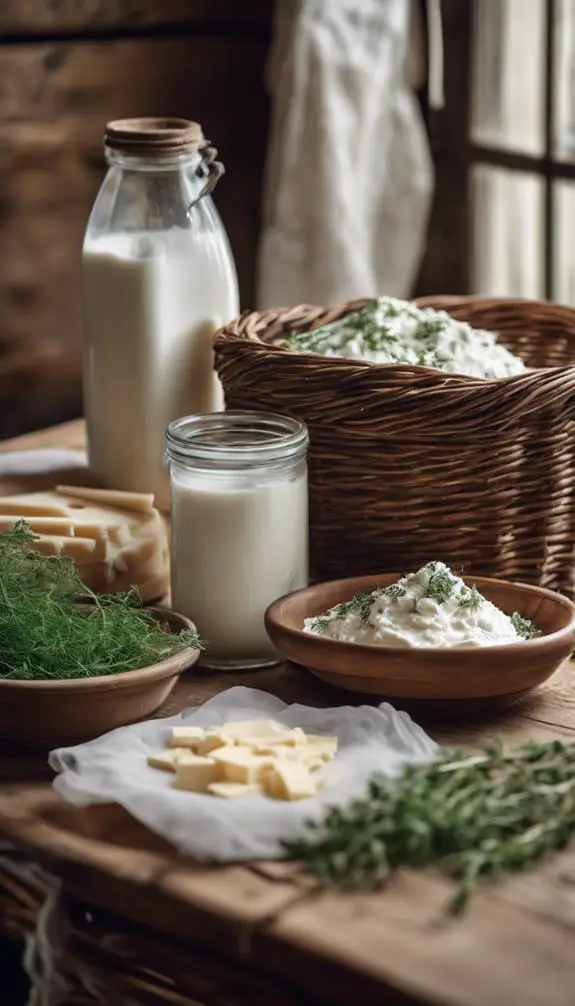
Dehydrating dairy products is a game-changer for anyone looking to reduce food waste and extend the shelf life of their favorite milk-based staples.
You can dehydrate dairy alternatives like almond milk, soy milk, and coconut milk to create a sustainable supply of non-perishable milk options.
When it comes to yogurt preservation, you can dehydrate it to make a powder that can be reconstituted with water when needed.
This is especially useful for backpackers, campers, or anyone living off the grid.
Canned Goods Vs Dehydrated Foods
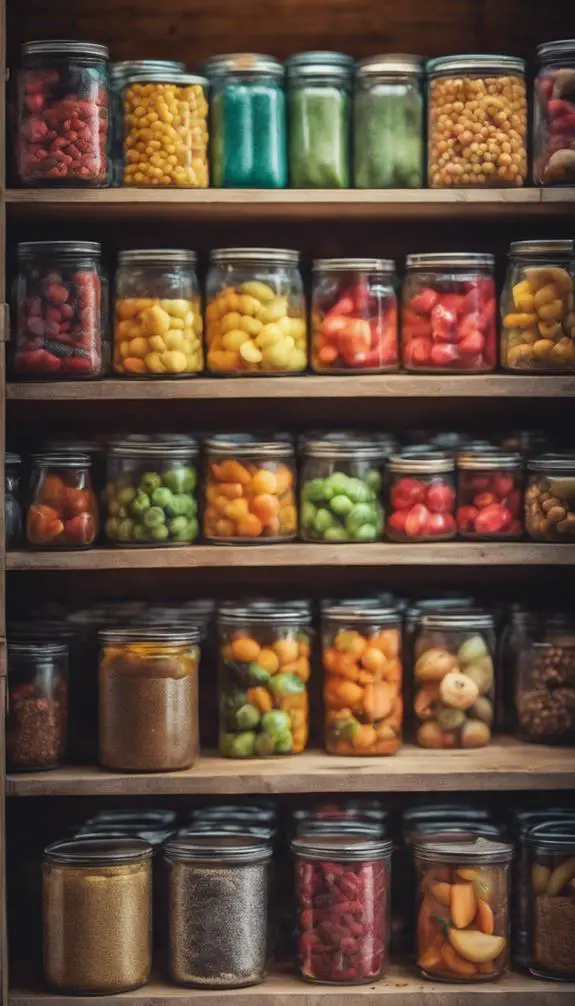
Your pantry is likely stocked with canned goods, a convenient and shelf-stable option for many foods.
However, when it comes to long-term survival storage, dehydrated foods have some significant advantages. For one, dehydrated foods take up less space on your food shelf, making them ideal for storage in small areas.
They're also lighter, making them easier to transport if you need to evacuate. Additionally, dehydrated foods can be stored for longer periods of time using various storage methods, such as airtight containers or Mylar bags.
In contrast, canned goods have a shorter shelf life and can become heavy and cumbersome. By incorporating dehydrated foods into your storage plan, you'll have a more flexible and sustainable option for long-term survival.
Spices and Herbs for Flavor

How do you plan to add flavor to your dehydrated meals in a survival situation?
Having a stockpile of spices and herbs can make all the difference in making your meals palatable. Dehydrated spices and herbs are lightweight, compact, and retain their Flavor Boosters and Aromatic Essentials.
Basil, oregano, thyme, and rosemary are all excellent choices to add depth and complexity to your meals. You can also dehydrate garlic, onion, and chili peppers to add a punch of flavor.
Consider dehydrating lemon or orange peel to add a burst of citrus flavor. By incorporating these Flavor Boosters into your survival storage, you'll be able to create meals that not only sustain you but also bring you comfort and joy.
Dehydrated Pet Food Options
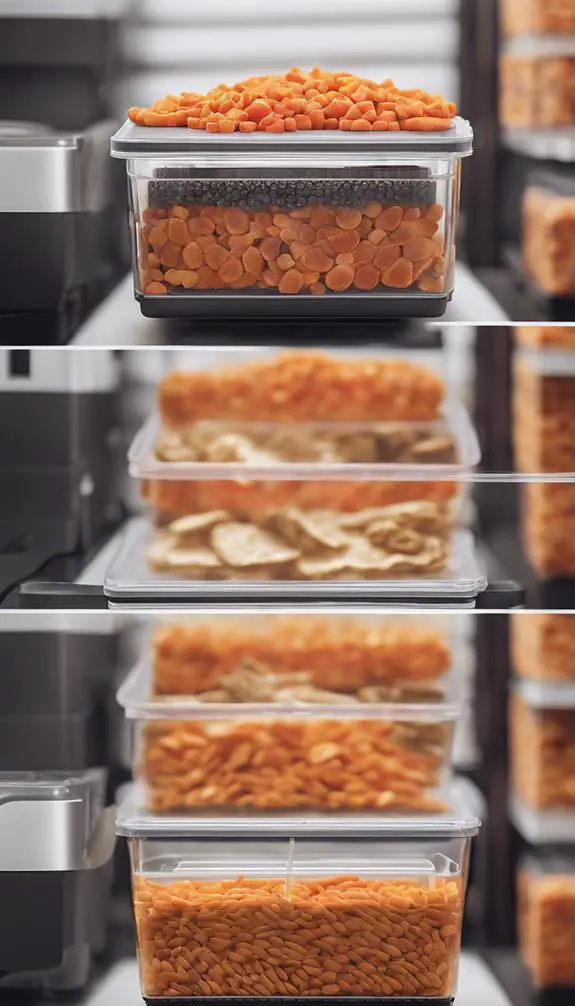
As you prepare for emergency situations, don't forget about your furry friends – they'll need sustenance too.
Dehydrating pet food is a great way to guarantee your pets stay healthy and happy during a crisis. You can dehydrate pet food recipes that mimic commercial pet nutrition, using ingredients like chicken, beef, fish, and veggies.
Consider dehydrating sweet potatoes, green beans, and carrots for a nutrient-rich pet food. You can also add supplements like omega-3 fatty acids and probiotics to support your pet's overall health.
Baby Food and Toddler Snacks
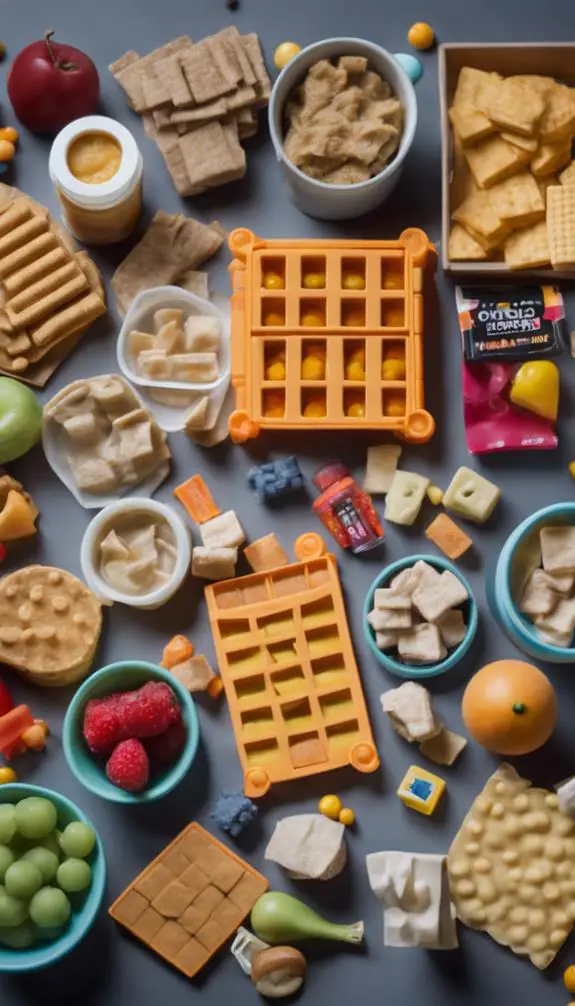
Dehydrate a variety of fruits, veggies, and meats to create healthy, convenient baby food and toddler snacks that are perfect for on-the-go or emergency situations.
You can make baby purees by dehydrating fruits like apples, bananas, and berries, then blending them into a powder. Simply mix with breast milk or formula to create a nutritious meal.
For toddlers, dehydrate veggies like carrots, sweet potatoes, and green beans to make crispy treats that are easy to pack and fun to eat.
You can also dehydrate meats like chicken and beef to make protein-rich toddler treats. Store them in airtight containers for up to 25 years, and you'll have a stash of healthy snacks ready when you need them.
Gluten-Free Dehydrated Options
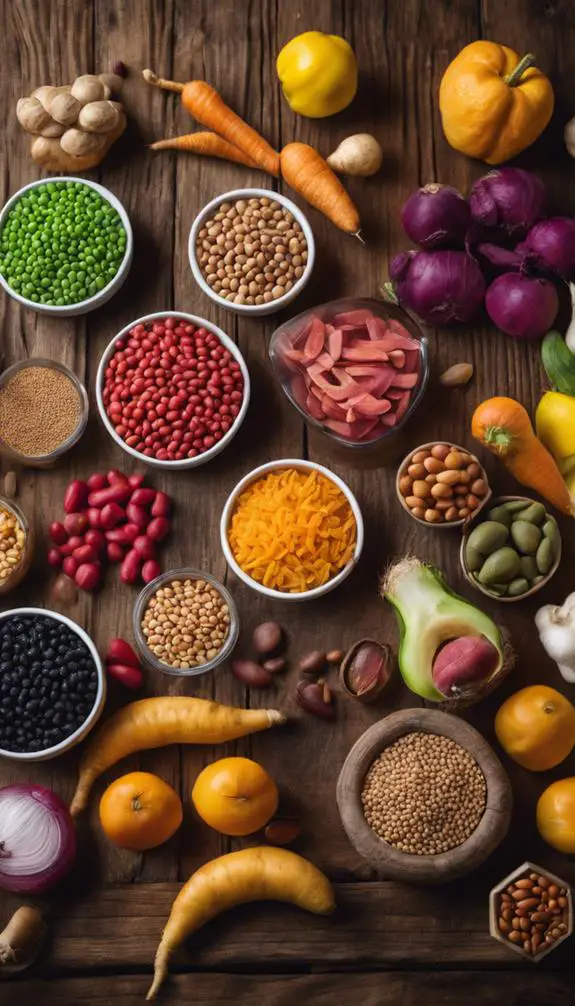
With gluten intolerance and sensitivity on the rise, having gluten-free dehydrated options on hand is vital.
You'll want to stock up on gluten-free alternatives like rice, corn, and quinoa that can be used in a variety of dishes.
Dehydrating gluten-free fruits and vegetables like strawberries, blueberries, and sweet potatoes will provide you with healthy and convenient snacks.
Celiac friendly options like gluten-free oats, almond flour, and coconut flakes can be used to make delicious and nutritious granolas and energy bars.
Rehydrating and Cooking Tips

When rehydrating your dehydrated foods, timing is crucial. Don't believe the dehydration myths that claim rehydration is a complicated process.
In reality, it's quite simple. There are several rehydration methods to choose from, depending on the type of food and your personal preference.
You can rehydrate using hot or cold water, or even add the dehydrated food directly to your recipe. For most foods, a 1:1 ratio of food to water is a good starting point.
Adjust the ratio as needed to achieve your desired texture. When cooking, use low heat to prevent nutrient loss.
Reconstitute your food in a sealed container or bag to retain moisture and heat. With a little practice, you'll master the art of rehydrating and cooking your dehydrated foods.
FAQs
Can I Dehydrate Food in the Oven Instead of a Dehydrator?
You can dehydrate food in your oven, but it's vital to maintain a low oven temperature (135-150°F) and guarantee even drying by rotating trays and checking on food regularly to avoid overcooking or under-drying.
How Do I Prevent Mold Growth on Dehydrated Foods in Storage?
You'll prevent mold growth on dehydrated foods in storage by using air-tight containers and desiccant packets to control humidity, ensuring your hard work stays fresh and safe for consumption.
Can Dehydrated Food Be Used in a Regular Recipe Without Rehydration?
When you're whipping up daily meals, you can definitely use dehydrated ingredients without rehydrating them first, and they'll still add depth to your flavor profiles – just adjust cooking times and liquid levels accordingly, and you're good to go!
Is It Safe to Dehydrate Food With High Water Content Like Watermelon?
When dehydrating high-water fruits like watermelon, you'll end up with chewy, sweet chunks or a delicious fruit leather, but beware of mold growth and spoilage – guarantee proper temperature and humidity control to keep your harvest safe.
Do Dehydrated Foods Lose Their Nutritional Value Over Time?
You're right to wonder: do dehydrated foods lose their nutritional value over time? Thankfully, nutrient retention remains high if stored properly, and vitamin stability is maintained, especially for fat-soluble vitamins, ensuring you'll still reap the benefits of your hard work.
Conclusion
You've now got an exhaustive list of the best foods to dehydrate for long-term survival storage. By preserving fruits, veggies, meats, and snacks, you'll have a reliable supply of nutrients and energy when you need them most. Remember to store them properly, and don't forget to rehydrate and cook them correctly when the time comes. With these dehydrated foods, you'll be well-prepared to face any emergency situation that comes your way.

